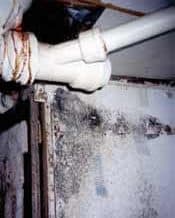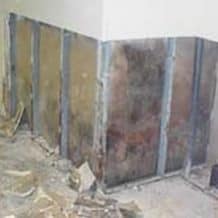Mold Prevention Tips

Control dampness – Moisture is the key ingredient for mold growth. Cleaning and keeping the area dry will help prevent mold from regrowing. If conditions aren’t improved, mold can regrow in as little as twenty-four hours after the area was cleaned. Keep the humidity level in your home between 40% and 60%. Use an air conditioner or a dehumidifier during humid months and in damp spaces, like basements.
Image: Moldy basement wall due to leaky pipe.
Reduce indoor humidity (to 30-60% ) to decrease mold growth by: venting bathrooms, dryers, and other moisture-generating sources to the outside; using air conditioners and de-humidifiers; increasing ventilation; and using exhaust fans whenever cooking, dish-washing, and cleaning.
Humidity levels should stay between fifteen percent (15%) and below forty percent (40%) during the heating season, depending on the outdoor temperature.
Fix any leaks in your home’s roof, walls, or plumbing so mold does not have moisture to grow. It is important to dry water damaged areas and items within 24-48 hours to prevent mold growth.
Add mold inhibitors for mold prevention to paints before painting.
Clean bathrooms with mold-killing products.
Remove or replace carpets and upholstery that have been soaked and cannot be dried promptly. Consider not using carpet in rooms or areas like bathrooms or basements that may have a lot of moisture.
Dead mold can continue to cause allergic reactions in some people so it is important that the mold is properly managed, neutralized and also removed.
To learn more about preventing mold in your home, see the Environmental Protection Agency’s publications about mold at
https://www.epa.gov/mold/
Next : How to Avoid Sick-House Syndrome
read more






